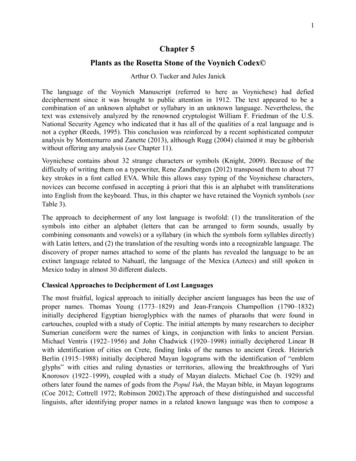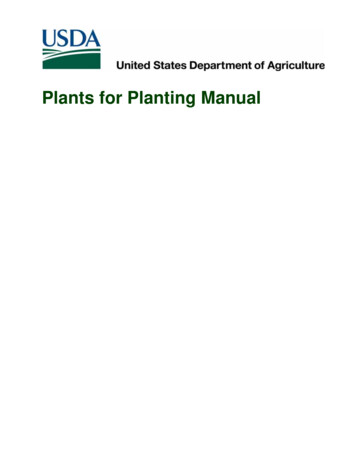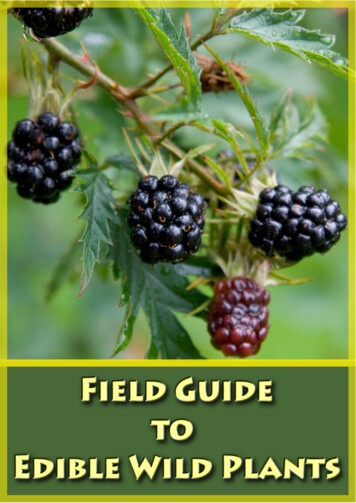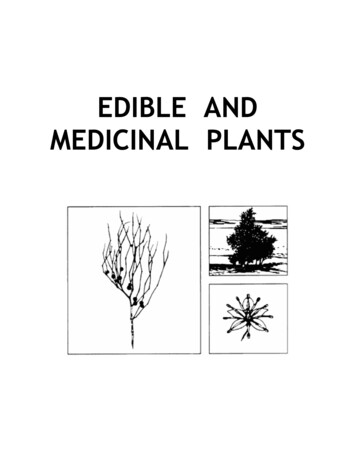
Transcription
1Chapter 5Plants as the Rosetta Stone of the Voynich Codex Arthur O. Tucker and Jules JanickThe language of the Voynich Manuscript (referred to here as Voynichese) had defieddecipherment since it was brought to public attention in 1912. The text appeared to be acombination of an unknown alphabet or syllabary in an unknown language. Nevertheless, thetext was extensively analyzed by the renowned cryptologist William F. Friedman of the U.S.National Security Agency who indicated that it has all of the qualities of a real language and isnot a cypher (Reeds, 1995). This conclusion was reinforced by a recent sophisticated computeranalysis by Montemurro and Zanette (2013), although Rugg (2004) claimed it may be gibberishwithout offering any analysis (see Chapter 11).Voynichese contains about 32 strange characters or symbols (Knight, 2009). Because of thedifficulty of writing them on a typewriter, Rene Zandbergen (2012) transposed them to about 77key strokes in a font called EVA. While this allows easy typing of the Voynichese characters,novices can become confused in accepting à priori that this is an alphabet with transliterationsinto English from the keyboard. Thus, in this chapter we have retained the Voynich symbols (seeTable 3).The approach to decipherment of any lost language is twofold: (1) the transliteration of thesymbols into either an alphabet (letters that can be arranged to form sounds, usually bycombining consonants and vowels) or a syllabary (in which the symbols form syllables directly)with Latin letters, and (2) the translation of the resulting words into a recognizable language. Thediscovery of proper names attached to some of the plants has revealed the language to be anextinct language related to Nahuatl, the language of the Mexica (Aztecs) and still spoken inMexico today in almost 30 different dialects.Classical Approaches to Decipherment of Lost LanguagesThe most fruitful, logical approach to initially decipher ancient languages has been the use ofproper names. Thomas Young (1773–1829) and Jean-François Champollion (1790–1832)initially deciphered Egyptian hieroglyphics with the names of pharaohs that were found incartouches, coupled with a study of Coptic. The initial attempts by many researchers to decipherSumerian cuneiform were the names of kings, in conjunction with links to ancient Persian.Michael Ventris (1922–1956) and John Chadwick (1920–1998) initially deciphered Linear Bwith identification of cities on Crete, finding links of the names to ancient Greek. HeinrichBerlin (1915–1988) initially deciphered Mayan logograms with the identification of “emblemglyphs” with cities and ruling dynasties or territories, allowing the breakthroughs of YuriKnorosov (1922–1999), coupled with a study of Mayan dialects. Michael Coe (b. 1929) andothers later found the names of gods from the Popul Vuh, the Mayan bible, in Mayan logograms(Coe 2012; Cottrell 1972; Robinson 2002).The approach of these distinguished and successfullinguists, after identifying proper names in a related known language was then to compose a
2dictionary of cognates and then construct a grammar, paying particular attention to prefixes,suffixes, and internal letter or syllable arrangement in context.We note that, in almost all cases of these successful decipherments, the linguistic community didnot immediately accept their conclusions, and nasty and libelous statements were issued by theircontemporaries, sometimes for ten to thirty years after publication of the seminal papers.However, these successful linguists and their approaches are heralded today, while theirillogically harsh contemporary critics are forgotten.Deciphering the Language Symbols of the Voynich ManuscriptThe characters of Voynichese are unique but similar in concept to the Cherokee syllabary createdby Sequoyah (George Gist) in 1821 by modifying letters from Latin, Greek, and Cyrillic that hehad encountered. The resulting Cherokee syllabary did not carry along the pronunciations fromthe original language, and many new characters were created that had no direct correspondencewith existing languages but were obviously inspired by them.An examination of documents from pre-1600 from Nueva España reveals one, the Codex Osuna(Valderrama 1600), that shows letters similar to some of the symbols in the Voynich ManuscriptThe four most unique symbols in the Voynich Codex are t, s, p, and d. In fol. 12v andelsewhere in the Codex Osuna, also in as well Codex Aubin (Anon. 1576), there is a version of“tl” in Nahuatl that matches the same character t found in the Voynich Manuscript (Fig. 1A).This character for “tl” from the Codex Osuna is unique in that it also accompanies the samepronunciation in Voynichese. Throughout the Codex Osuna, the Nahuatl “s” (Fig. 1B) is writtenas a large, conspicuous backward version of that found in the Voynich Manuscript s with the newpronunciation of “n.” On fol. 13v and 14r of the Codex Osuna the florid Spanish signatures (Fig.1C) have several inspirations for the p in the Voynich Ms. with the new pronunciation of“hu/gu.” On fol. 12v of the Codex Osuna, the “nj” sound in the word naranjas accompanying thepicture of orange fruits (Fig. 1D) resembles the d in the Voynich Manuscript which has thepronunciation “ch”.
3Fig. 1. Calligraphy in the Codex Osuna with corresponding symbols from the VoynichManuscript. (A) “tl” in Nahuatl words from fol. 12v matching the Voynichese character t; (B)“s” in Nahuatl words from fol. 7r when reversed matches the Voynichese s; (C) A florid Spanishsignatures from fol. 13v inspiring the Voynichese p; (D) “nj” from fol. 12v from the CodexOsuna for naranjas (a Nahuatl word borrowed from the Spanish meaning oranges) matching theVoynichese d.We thus conclude that the author of the Voynich Codex made up his syllabary/alphabet, and theletters were borrowed from contemporary post-Conquest MesoAmerican manuscripts such as theCodex Osuma. This would imply that the author was a scribe and had access or participated inthese manuscripts.Applying this background to the Voynich Codex, the next approach was tomatch proper names of the identified phytomorphs with names of plants in dialects of Nahuatl. Inthe 12 pages of the Pharmaceutical section of the Voynich Manuscript where jars, roots, leavesand shoots are portrayed (99v to102v; there are two folios of three pasted pages) at least 179plants, plant parts, or mineral are illustrated, with 152 accompanied by names. This is the RosettaStone of the Voynich Manuscript!properPlant #8 of the 16 plants in fol. 100r was identified as a cactus pad, probably Opuntia ficusindica or a related species (Table 1). Thus, the Voynichese name, soity can be associated withthe name nochtli, the Nahuatl name for either fruit of the prickly pear or the plant bearing thefruit. Later, with more transliterations, we refined this to nashtli. This name confirms the use ofcalligraphy from the Codex Osuna, using two letters, s and t suggesting we are in the righttrack. This transliteration provides the sound of 5 Voynichese letters: s n, o a, i sh, t tland y is the sound i or y.
4Next, plant #4 of fol. 100v was identified as the pressed specimen of a young yucca species orAgave species (possibly A. atrovirens or a related species) with the name chopary (Table 1) thatcan be transliterated to maguoey, a variant of the Taino name, maguey, that entered Spanish in themid-16 century. This adds the sound of 3 new Voynichese letters: ch m, p gu/hu, and r e.With these initial letters, additional letters of the syllabary/alphabet of Voynichese was thendeciphered by matching phyto-, zoo-, and geomorphs to proper names in languages of centralMexico, later adding diacritical marks when compared with Classical Nahuatl to produce thefollowing syllabary. Proper names in Voynichese listed in Table 1 provides the pronunciation of14 Voynichese symbols listed in red in Table 1 and underlined in Table 2. All of the V-ynichsmbols were then decoded to Latin equivaents with appropriated diacritical marks in Table 2with here frequence in Voynich as well as in 17th century Classical Nahuatal.Table 1. Critical phyto-, zoo-, and geomorphs and city in the Voynich Manuscript whose propernames allowed the preliminary development of a Voynichese syllabary/alphabet.Fol. &plant # ofVoynichPhyto-, Zoo-, or Geomorph orManuscript CityBotanicals100r #8VoynicheseTransliterationsoitynāshtlis no āi sh/xt tly i/yRed lettersare newdeciphermentsCognate,translation, &identificationnochtli(Nahuatl) fruit(tuna) of the pricklypear cactus or theplant bearing thefruitmost probablyrooted cladode ofOpuntia ficusindica
5100r #4Choparymāguoeych mo āmaguey (Spanishfrom Taino mid-16thcentury)most probablyAgave atrovirensp gu/hua or ey i/y88r #11opaldoāguocâchāo āp gu/huagua (Spanish) water cacha(Nahautl) callusmost probably alupine(Lupinus montanus)a ol câd cho ā99r #16,86v, 1vceokymātlich mo āmatli (Nahuatl) animal front leg,branchesunknown roott tly i/y99r #28tolsasyt tlo āl câs na otlācânonitlacanoni (Nahuatl) bat or paddlemost probablycamote del cerro
6s ny i/y99v #10daiinechollad cha ounknown, perhapsroot ofCylindropuntia sp.iin lle a99v #18olkyo āl câk tly i/ycholla (Spanish) skull, cactusācâtliacatli (Nahuatl) reedunknown, perhapsroot of a reed
7100r #1ceosaroSeolmānoetzācâch mo ās nmano (Spanish) hand tzacua(Nahuatl) to close,encloseunknown, perhapsan Agave sp.?a or eo āSh ts/tzo āl câ100r #2sochorcFeys no āch mo ānāmāepinama (Mixtec) plant whichproduces soapmost probablyPhilodendronmexicanumr ecFe py i/y100r #5sar char daiin noe, moe-choll- cholla (Spanish)chi skull chidy(Nahuatl) rootword for owls na oe ace ma or ed cha oiin lld chmost probably 3flowers of bladdersage or paperbagbush (Scutellariamex
8y i/y100r #7ceolsainmācanolch mo āl câicana)macana (Taino) obsidian &wooden swordsimilar to the Aztecmacuahuitl(Nahuatl)s na oin lmost probablyPhilodendrongoeldii100r #14olcheomo āl câce me ao ām yâ/hâācâmaāyaacamaya (Nahuatl) crab or crayfishmost probably fruitof Gonolobuschloranthus
9okols100r #15ātlācâno āk tlatlacaneci(Nahuatl) bestialmanunknown, perhapsMexican cypress,Montezuma cypress(Taxodium huegelii)o āl câs nMineraloteos102r #4ātlaāno āt tle aatlan (Nahuatl) inor under water(probably referringto the blue color)most probably themineral boleiteo ās nAnimalotolal70ro āt tlo āl câa ol câCityātlācâocâatlaca (Nahuatl) fishing folk aca(Nahuatl) someonemost probably thealligator gar(Atractosteusspatula)
10pairotalcPhy86v(sphere 2)huoxeātlocâpip hu/gua oi sh/xr eo āt tla ol câcPh py i/yotchdasas86v(sphere 8)Altmchononhuoxeatl(Nahuatl) willow capi Spanish forLatin Americancapital cityMonastery of SanMiguel Megun ca.1543, Huejotzingo,Puebla (México),spelled in perioddocuments andmaps asHuexucinco,Huexutcinco,Huexotzinco, orGuaxocingoaltmchonon waterseller based onNahuatl cognates:atl m aca water someone andchonon seller.Water seller nickname for VeraCruzTable 2. Voynichese characters with proposed Latin equivalent letters or syllables. Voynichesecharacter counts and percent frequencies (out of 160,602 total characters) were calculated fromKnight (2009). Selected 17th century Nahuatl incantations of a ticitl (doctor or seer) from Alcarón(1987, Sixth Treatise, Chapters 1–24) were typed and percent frequencies were then calculated toget an approximation of early Nahuatl as a comparison (9,451 total characters). EVA EuropeanVoynich equivalent.VoynichcharacterProposed LatinequivalentzāEVAoeae25,468 15.9%20,227 12.6%ā 609 6.4%a 753 8.0%yi/yy17,655 11.0%i 1318 y 160 1478 15.6%k16,020 10.0%tl 443 4.7%okt}tlVoynichese character count &frequencyCount & frequency 17th century ClassicalNahuatltaoa14,281 8.9%o 685 7.2%dchd12,973 8.1%ch 125 1.3%chmch11,008 6.9%m 285 3.0%lcâl10,471 6.5%ca 180 1.9%er6,716 4.2%e 449 4.8%r
11qu/kwq5,423 3.4%qu 214 2.3%Shts/tzSh4,501 2.8%tz 113 1.2%iinlliin4,076 2.5%ll 53 0.6%s2,886 1.8%n 741 7.8%cKe1,858 1.2%cu 85 0.9%1,844 1.1%hu 306 uh 155 461 4.9%4scKhcThfpn}}cuhu/gufplin1,752 1.1%l 710 7.5%myâ/hâm1,046 0.7%ya 13 ha 2 15 0.2%irc/kir591 0.4%c 496 4.9%x?xish/xi524 0.3%(listed by Knight as *?)316 0.2%x 206 2.2%cFe291 0.2%p 148 1.6%incFhcPhzcTe}pcPenz/çn157 0.1%z 351 3.7%iiintiiin156 0.1%t 545 5.8%iir?iir148 0.1%ghg96 0.1%im?im52 0.1%il?il31 0.1%iim?iim17 0.1%iil?iil14 0.1%iiil?iiil2 0.1%iiim?iiim1 0.1%iiir?iiir1 0.1%vDecipherment not underlined is tentativeh 306 3.2%vCognates of Voynichese in Classical NahuatlBesides the proper names attached to the plants, animals, mineral, and cities, a number of otherwords in the Voynich Manuscript have cognates in Classical Nahuatl, providing evidence thatVoynichese is not Classical Nahuatl but is related to a dialect of Nahuatl. These are listed inTable 3. The use of “tl” and “chi” (or “chy”) endings places this dialect of Nahuatl in central ornorthern Mexico (Canger 1988; Lacadena 2008).Table 3. Selected words in Voynichese with cognates in Classical Nahuatl of 16th century NuevaEspaña.Fol.1v, 86v99vVoynichese wrongsymbolsololdyTransliterationācâCognates & translationaca (Nahuatl) someoneācâchiAcachi is located in the municipality ofUrique in the Mexican state of
12Chihuahuaacan (Nahuatl) in any place, in anypartahuitl choca (Nahuatl) to weep for anauntahuoj (Nahuatl) dry oparāhu/guoe88rosalānocâ86votoātlāAnoca is located in the municipality ofTechaluta de Montenegro in the Mexicanstate of Jaliscoatla (Nahuatl) place of abundant water86v, 1rotolātlācâatlaca (Nahuatl) mean people102rotocThaātlācuoatlacui (Nahuatl) to draw water88rotorchetyātlāematli99votechyātlamiatla (Nahuatl) place of abundant water matli (Nahuatl) animal front legatlamica (Nahuatl) drowning88vototolātlātlācâatlatlac (Nahuatl) flooded (field)88r, 99vototyātlātliatlatl (Nahuatl) spear-thrower1r, 86v, 99rotyātliatli (Nahuatl) to drink water or cocoa86vomāyâ/hâaya (Nahuatl) not yet1vlolcâācâcaca (Nahuatl) frog, toad88vdolychācâichacah (Nahautl) tip of a tree86vdoiinychāllichicalli (Nahuatl) spittle1r, 1vdalchocâ100vdalsychocânichoca (Nahuatl) to weep, cry; foranimals to make various soundschocani (Nahuatl) a weeper1r, c (Nahuatl) at the end, at the top,aftercui (Nahuatl) to take something orsomeone (see qua) cui (Nahuatl) toeatitloc (Nahuatl) by, with against1vchomāma (Nahuatl) preceding the imperative1r, 1vcholmācâ1r, 1vcharmoe99rsalonocâāmaca (Nahuatl) sing. of macamo, no(before the imperative)mo (Nahuatl) C negative particle on itsown in questions expressing doubtnoca (Nahuatl) while
etlachia (Nahuatl) to look, see, orobserve from a watchtowertla (Nahuatl) something, if1r, 1v, 86vSholts/tzācâtzaca (Nahuatl) to enclose, lock up100rSeocThoyts/tzācuāitzacua (Nahuatl) close, to enclose-itloc (Nahuatl) adjacent to, close to ana (Nahuatl) to seize cama(Nahuatl) letpa (Nahuatl) color, dye, paintpaca (Nahuatl) to wash, bathe, laundersomethingqua (Nahuatl) biting, eating someone(see cua)tlaca (Nahuatl) menOrthography of Voynichese and Comparison to NahuatlFrom the proper names, a table of syllables and letters was then developed. In Table 3, thefrequency numbers from Knight (2009) from the Voynich Manuscript are indicated in theparentheses and compared with 17th century Nahuatl incantations from Alcarón (1987). Thiscomparison shows that Voynichese is similar but not identical to Classical Nahuatl, i.e., it may bea dialect of Nahuatl (most likely extinct).We also note that transliteration of the proper names in historical sources show the samephoneme being written as gu vs. hu (likewise ts vs. tz and x vs. sh), depending upon the sourceand time. For example, Sir Francis Drake sacked a town in April 1579 listed in contemporaryaccounts as Guatulco in the Gulf of Tehuantepec, Mexico; no Guatulco exists on current maps ofMexico, but Huatulco occupies the same geographical location. Also, comparing words in theVoynich Manuscript in compiling a dictionary, it appeared that the variants of “tl” (t, k) and“cu” (cTh, CKh) may have been the result of quick, sloppy writing, and these are not separatecharacters.Nahuatl is the language of the Nahua, including the Mexica, the chief tribe of the Triple Alliance,popularly known as the Aztecs, and their predecessors. Nahuatl, a language of the Uto-Aztecanlanguage family, has been spoken in central Mexico since the 7 th Century CE. The Conquestintroduced the Latin alphabet to writing Nahuatl; the Tenochtitlan variety is known as ClassicalNahuatl. With almost 30 recognized dialects of Nahuatl today, it is difficult to apply generalorthographic principles that cover all of dialects, but surveying Nahuatl dictionaries andgrammars (Bierhorst, 1985; Canger, 1985; Herrera, 2004; Karttunen, 1983; Lacadena, 2008;Launey, 2011; Lockhart, 1990, 2001; Robinson, 1969; Siméon, 2010; Sullivan, 1997; Walters et
14al., 2002; Whittaker, 2009), the syllabary/alphabet that we developed for Voynichese agrees withthe basics.Pre-conquest Nahuatl was ideographic, and attempts to transcribe the Nahuatl phonemes intoSpanish evolved into some customary orthographic principles for Nahuatl today. Short vowelsare written without diacritical marks (“a,” “e,” “y/i,” “o”) in transcribing Nahuatl into Spanish.The letter “u” by itself is not part of Nahuatl, but the vowel “o” is sometimes written as “u” whenthe pronunciation approaches that of the Spanish and English. Vowel length is conventionallyunrepresented but, when it is written, the conventions is that of the macron (“ā”). Fortypographical reasons, the circumflex (“â”) is also used. Double vowels (“aa”) are notuncommon but typically belong to different syllables.The Nahuatl phonemes “p,” “t,” l/r” “n,” and “m” are written as the Spanish (“p,” “t,” “l,” “r,”“n,” “m”). The letter “s” is not used in Classical Nahuatl, but “c” before “e” or “i” is pronouncedlike the English “s,” and “z” is also pronounced like the English “s” (“ç” may be used sometimesin place of “z” in transliteration). The Spanish “tl” (as a consonant rather than a full syllable),“ts/tz,” “ch,” “x,” “cu” (not a syllable), and “hu/uh” are attempts to approximate the Nahuatlphonemes (Spanish does not have a “w” but some modern linguists now use the English “w”instead of the Spanish “hu”). The Nahuatl phoneme “k” is written as a “c” when preceding aback vowel or consonant and “qu” when preceding a front vowel.” “H” is an attempt toapproximate the Nahuatl phoneme and actually represent a “silent” glottal stop. The Nahuatldouble “ll” is not pronounced like the Spanish (“y”) but rather as a long “l.” Sometimes thisdouble “ll” is lost and written as one “l.” In some dialects, it is pronounced as “hl” and typicallywritten as ‘jl.” The letter “x” is pronounced in English as “sh.”These are the general guidelines of spoken Nahuatl into written Spanish that were formulated bythe Catholic priests of the 16 th and 17th centuries in Nueva España. However, if the VoynichManuscript was written by an amateur and not proofread by a Spanish priest, then we have toaccept that the transcribing of the Nahuatl phonemes may not have followed these generalities,further compounding the difficulty to transliterate Voynichese.SpanNahuatlLockhart (1992) outlines three phases in the development of Nahuatl in Nueva España: Stage 1encompassed the arrival of the Spaniards in 1519 to ca. 1540 to 1550 and was characterized byno change in Nahuatl. Stage 2 extended from 1540–1600 to the mid-17th century and sawmassive borrowing of Spanish nouns, but the Nahuatl language remained unaltered in otheraspects. Stage 3, from about 1640–1650 until today involves a deeper and broader Spanishinfluence.In the Voynich Manuscript there are various nouns that are either Spanish or combine bothNahuatl and Spanish (what we have called SpanNahuatl). Table 2 includes not only Spanishwords such as nanoya (grandmother) and but also the fusion of Spanish and Nahuatl words, suchas aguocâchā (agua, Spanish for water cacha, Nahuatl for callus). In other examples ofgeographical names, fol. 86v of the Voynich Manuscript provides pairotalCPhy or
15Huoxeatl(o)capi as an alternate name for Huejotzingo of today (alternately called Huexucinco,Huexutcinco, Huexotzinco, Guaxocingo in period documents and maps). This is a combinationof a cognate of the Nahualt huexotl for willow and the Spanish capi for Latin American capital.These examples of proper names provide evidence that the Voynich Ms. falls within Stage 2 ofthe development of the Nahuatl language, i.e., from 1540–1550 to 1640–1650.An Alphabetical Sequence of Voynich SymbolsFolio 57v displays four women’s heads and shoulders each with an arm extended in a circlesurrounding a “rosette” form (Fig. 2). Surrounding the figures are 4 rings of text. What isunusual, and may be a key to decipherment, is that Ring 2 from the top contains 17 symbolsrepeated four times in the same sequence. Nine of these symbols, o l d r k m f t y, are veryfrequent in Voynich. The other symbols, many of which are rare or absent in Voynich are hereignored. The assumption was made that the sequence contained important information and thefirst conjecture was that the sequence was alphabetical. To test this, the Voynich symbolsdecoded by Tucker and Talbert (2013) were put in sequential order based on the Spanish alphabetand compared to the sequence of f.57v (Table 4). We were immediately struck with the fact thatthe first four symbols, o l d r, in the sequence 1, 2, 3, 4, of f.57v had the same relativesequence as decoded symbols in the Spanish alphabet sequence (1, 3, 4 6).
16123Fig. 2. Folio 57v4567 89101112 131415 16 17
17Table 4. “Spanish alphabet” and corresponding Voynich character and sequence compared tosequence in f. 57v .Sequence1SpanishalphabetaSpanishpronunciation(a) amigoVoynich symbolbased on uence insymbol in f.57vf.57v1o2b(be) bonita3c(ce) cerealLcâL24chDchd35d(chhache)chocolate(de) dedo6e(e) españolRer4,127f(efe) feoinfl8g(ge) gato9h(hache) hormigaMhâM810i(i) iglesia11j(jota) José12k(ka) kilo13l14ll15m(eme) mamaCem16n(ene) nosn17ñ(eñe) ñoño18o(o) ojo19p(pe) pelo20q(cu) quemar21r(erre) ratón22s(ese) soso23t(te) tocarp, fhu/gu/uhfComments9See 28Irk/c ?(ele) loboktl?k7(elle) lluviatNahuatl tl llCe11cPh, cFhp4qu/kwish/xiiin ?tShts/tz24u(u) uva25v(uve) vamos26w27x(uvedoble)whisky(equis) xilófono28y(i griega) yateyy/i29z(zeta) zorroNz/çWhere does this come fromWhere does this come from?yWhere is symbol t as 1stletter of Tecamachalco,Tenochtitlan, Tepeaca,Texcoco, Tlatelolco,Tlaxacala?15Where does this come fromWe noted two similar sumbols, t and k, which had been assumed to be variant forms of t withthe diffence a result of sloppy calligraphy. Their presence together in f.56v indicates that twoseparate symbols are intentional. They were out of sequence assuming that they had a “tl” sound.However, the Nahuatl pronunciation of tl is given as follows:
18“This sound is a lateral fricative that doesn’t really exist in English. It sound like the “ll”in the Welsh name “Llewellyn.” Some English speakers fan pronounce it well if they tryto pronounce the “breathy l” in the word clue with the c in front of it. (http://www.nativelanguages.org/nahuatl guide.html)It seemed therefore that the t symbol should not be under “t” but under the letter “l” in theEnglish alphabet. Furthermore the Spanish alphabet contains two letter with the “l” sound: l andll, it was conjectured that t referred to the Spanish letter ll and k referred to the Spanish letter l.However, two other symbol, in l and iin ll, may have a similar pronunciation.Another problem was the symbol y which we had decoded as i/y. Transferring y from “i” to “y”in the alphabet improved the sequence. There was one other problem: the symbols R(pronounced e) appears twice, 5th and 12th in folio 57v. We have no explanation why his symbolis recorded twice.It was conjectured that these nine symbols taken together with pronunciations as above, wereclose to an alphabetical sequence (Table 4). It suggests that the author when inventing the code,started with the Spanish alphabet in sequence from a to z. If this is correct it supports most of thesymbol decipherment of Tucker and Talbert (2013). However, we were concerned with one issue.Many of the cities in Mexico begin with the letter t, e.g. Tecamachalco, Tenochtitlan, Tepeaca,Texcoco, Tlatelolco, Tlaxacala. It is unclear which Voynich symbol would be pronounced t at thebeginning of a word. Since we assumed that in that circle 4 in f.86v is Tlaxcalla, and that circle 6is Tecamachalco or possible Tepeaca, we had though that these word might be found in f.86v butwe have not found them. According to our translation of voynichese the cities beginning with theletter t might be spelled as follows: Tecamachalco iiin R L Ce o D o in Ir a; Tepeaca iiin RcFe R o L ;Tlaxcala t o i L k o or t o i L iin oConclusionManys of the symbols in Voynich have been decoded based on the association of Voynicheselabeled names on some plants with their names in Nahuatl or Spanish. Despite our apparentsuccess as decoding the voynich symbols and the decipherment of some plants, a mineral, ananimal, and a city, most of the text of Voynich defies translation suggesting that another languageis involved beside Classical Nahuatl. This may be a dialect or an extinct Meso-Amercianlanguage. This will be covered more fully in Chapter 13.
19Literature CitedAlarcón, H. R. de. 1987. Treatise on the heathen superstitions that today live among the Indiansnative to This New Spain, 1629. Transl. & ed. J. R. Andrews and R. Hassig. University ofOklahoma Press, Norman.Anonymous. 1576. Codex Aubin/Códice Aubin 1576/Códice de 1576/Historia de la w.britishmuseum.org/research/search the collection database/search object details.aspx?objectid 3008812&partid 1&searchText Aubin Codex¤tPage 1. (28January 2013).Bierhorst, J. 1985. A Nahuatl-English dictionary and concordance to the Cantares Mexicanoswith an analytic transcription and grammatical notes. Stanford University Press, Stanford,CA.Canger, U. 1988. Nahuatl dialectology: A survey and some suggestions. International Journal ofAmerican Linguistics 54:28–72.Chuchiak, J. F. 2012. The inquisition in New Spain, 1536–1820: A documentary history. JohnsHopkins Press, Baltimore, Maryland.Coe, M. 2012. Breaking the Maya code. Third ed. Thames & Hudson, New York.Cottrell, L. 1972. Reading the past: The story of deciphering ancient languages. J. M. Dent,London.Herrera, F. 2004. Hippocrene concise dictionary. Nahuatl-English, English-Nahuatl (Aztec).Hippocrene Books, New York.Karttunen, F. 1983. An analytical dictionary of Nahuatl. University of Oklahoma Press, Norman.Knight, K. 2009. The Voynich Manuscript.language/people/voynich.pdf. (1 May 2014).MIT.http://www.isi.edu/natural-Lacadena, A. 2008. Regional scribal traditions: Methological implications for the deciphermentof Nahuatl writing. PARI Journal 8:1–22.Launey, M. 2011. An introduction to Classical Nahuatl. Transl. C. Mackay. CambridgeUniversity Press, New York.Lockhart, J. 1990. Postconquest Nahua writing and concepts viewed through Náhuatl writings.Estudio de Cultura Náhuatl (México: UNAM Instituto de Investigaciones Históricas)20:91–116.Lockhart, J. 1992. The Nahuas after the Conquest: A social and cultural history of the Indians ofCentral Mexico, Sixteenth through eighteenth centuries. Stanford University Press,Stanford, CA.
20Lockhart, J. 1992. The Nahuas after the Conquest: A social and cultural history of the Indians ofCentral Mexico, Sixteenth through eighteenth centuries. Stanford University Press, Stanford,CA.Lockhart, J. 2001. Nahuatl as written. Lessons in older written Nahuatl, with copious examplesand texts. Stanford University Press, Los Angeles, CA.Montemurro, M. A., and D. A. Zanette. 2013. Keywords and co-occurrence patterns in theVoynich manuscript: An information-theoretic analysis. PloS ONE ds, J. 1995. William F. Friedman’s transcription of the Voynich Manuscript. Cryptologia19:1–23.Robinson, A. 2002. The man who deciphered Linear B: the story of Michael Ventris. Thames &Hudson, New York.Robinson, D. F., ed. 1969. Aztec studies. I. Phonological and grammatical studies in modernNahuatl dialects. Unniversity of Oklahoma, Norman, OK.Rugg, G. 2004. The mystery of the Voynich Manuscript: New analysis of a famously crypticmedieval document suggests that it contains nothing but gibberish. Scientific American291(1):104-109.Siméon, R. 2010. Diccionario de la lengua Nahuatl o Mexicana. Siblo Veintiuno, México.Sullivan, T. D. 1997. Primeros Memoriales de Fray Bernardino de Sahagún. Paleography ofNahuatl text and English translation. University of Oklahoma Press, Norman.Tucker, A. O., and R. H. Talbert. 2013. A preliminary analysis of the botany, zoology, andmineralogy of the Voynich Manuscript. Herbalgram 100:70–85.Valderrama, J. de. 1600. Pintura del gobernador, alcaldes y regidores de México, Osuna ibition-reading-europe/detail.html?id 108151. (4 January 2013).Whittaker, G. 2009. The principlesSprachwissenschaft Zandbergen, R. 2012 The Voynich manuscript. http://www.voynich.nu/index.html. (29 December2012.
1 Chapter 5 Plants as the Rosetta Stone of the Voynich Codex Arthur O. Tucker and Jules Janick The language of the Voynich Manuscript (referred to here as Voynichese) had defied decipherment since it was brought to public attention in 1912. The text appeared to be a combination of











